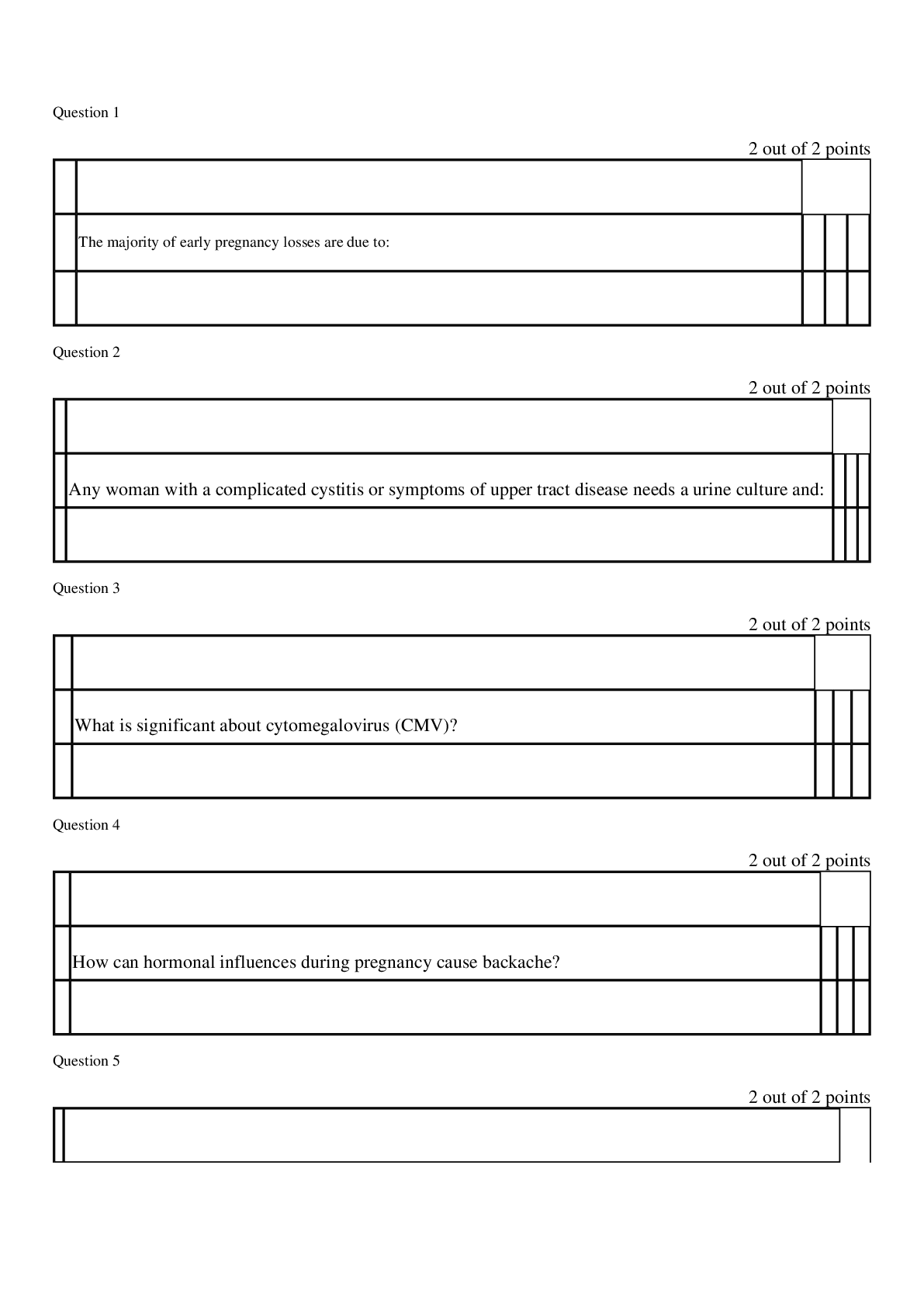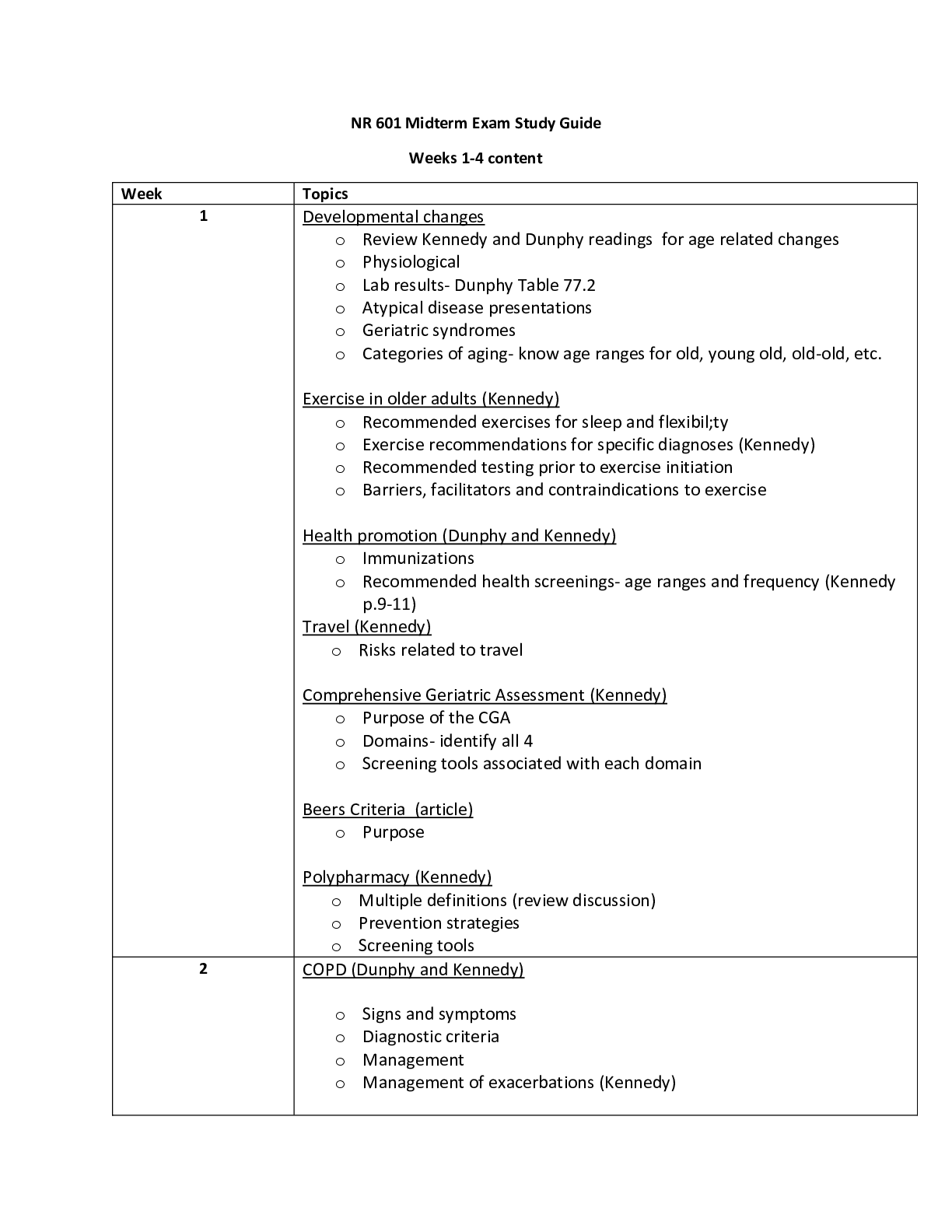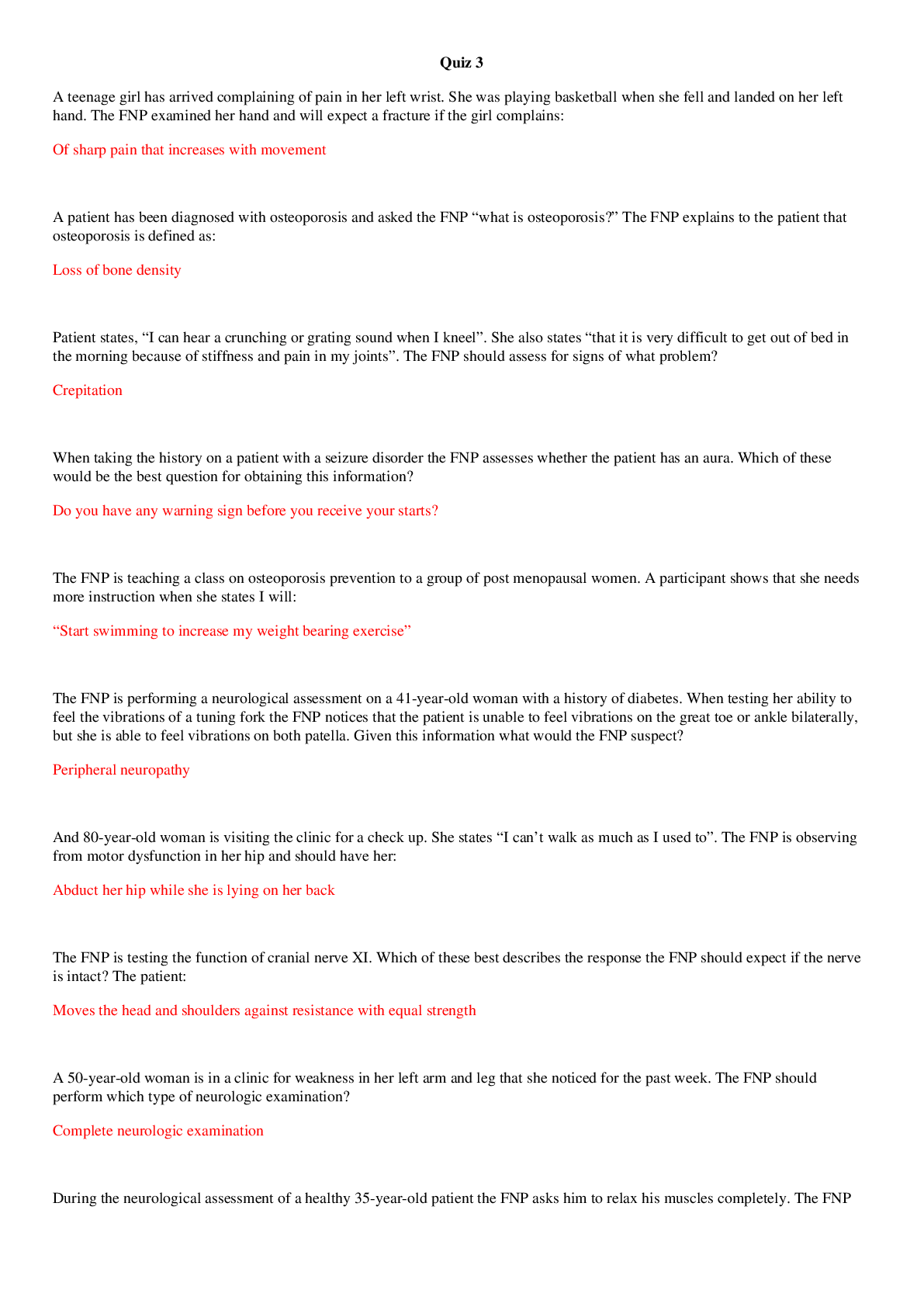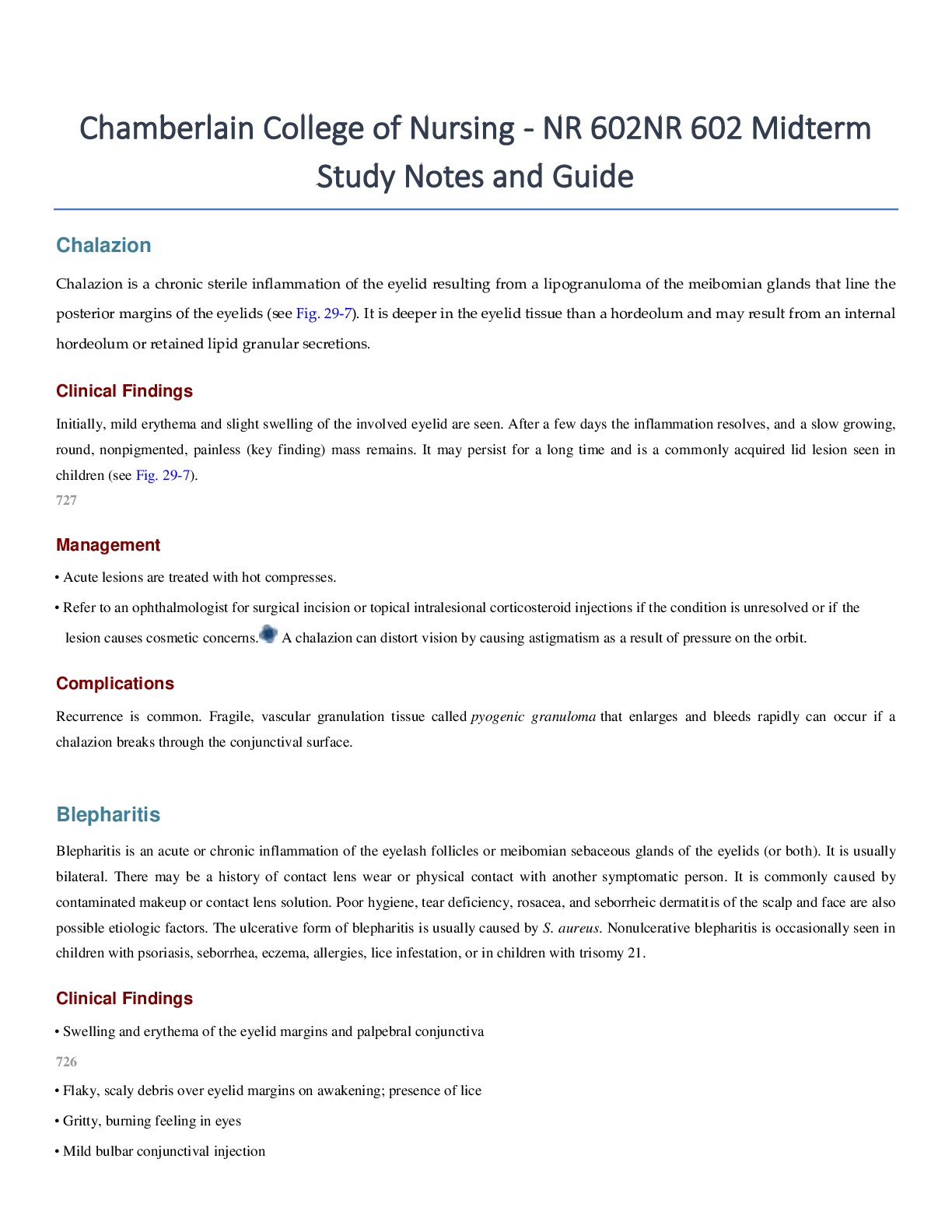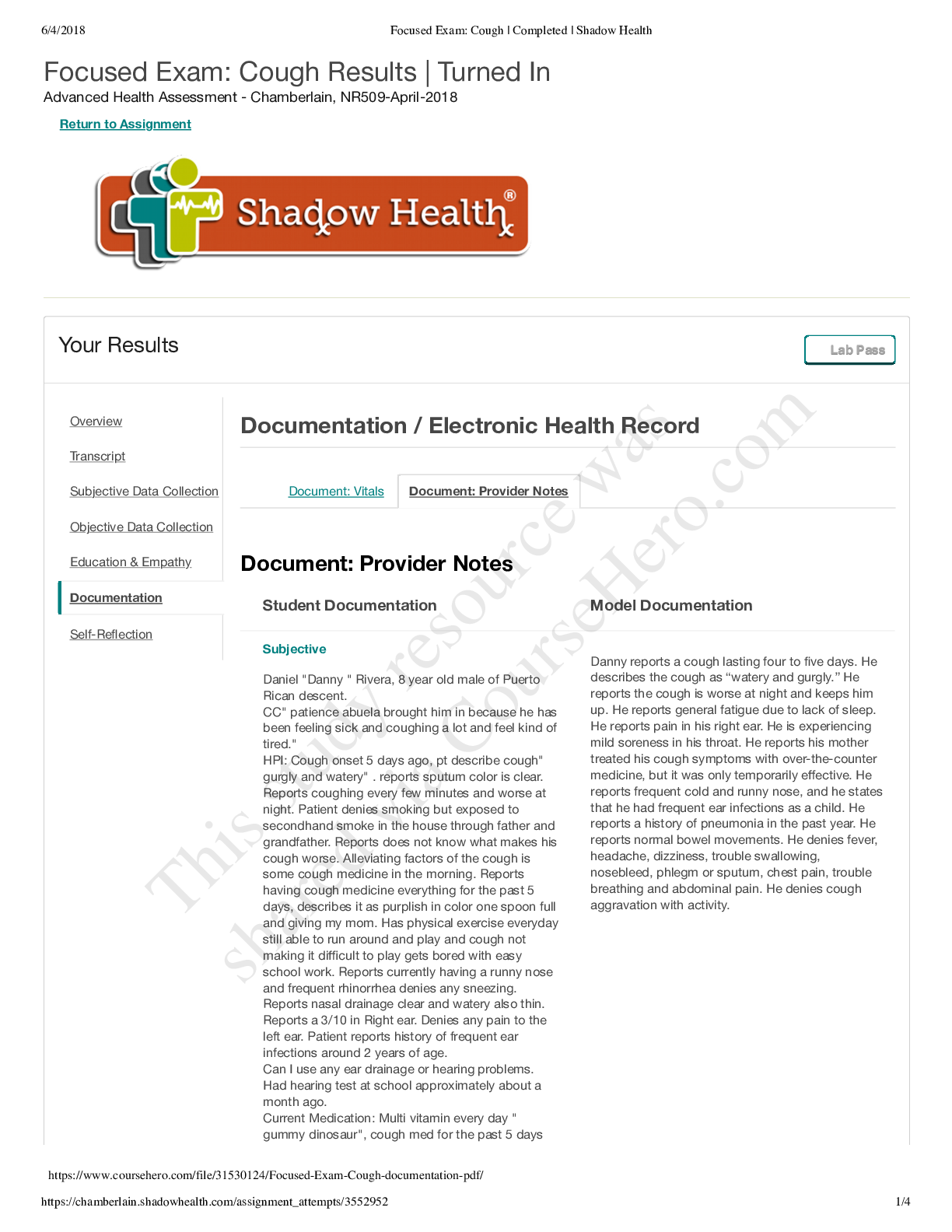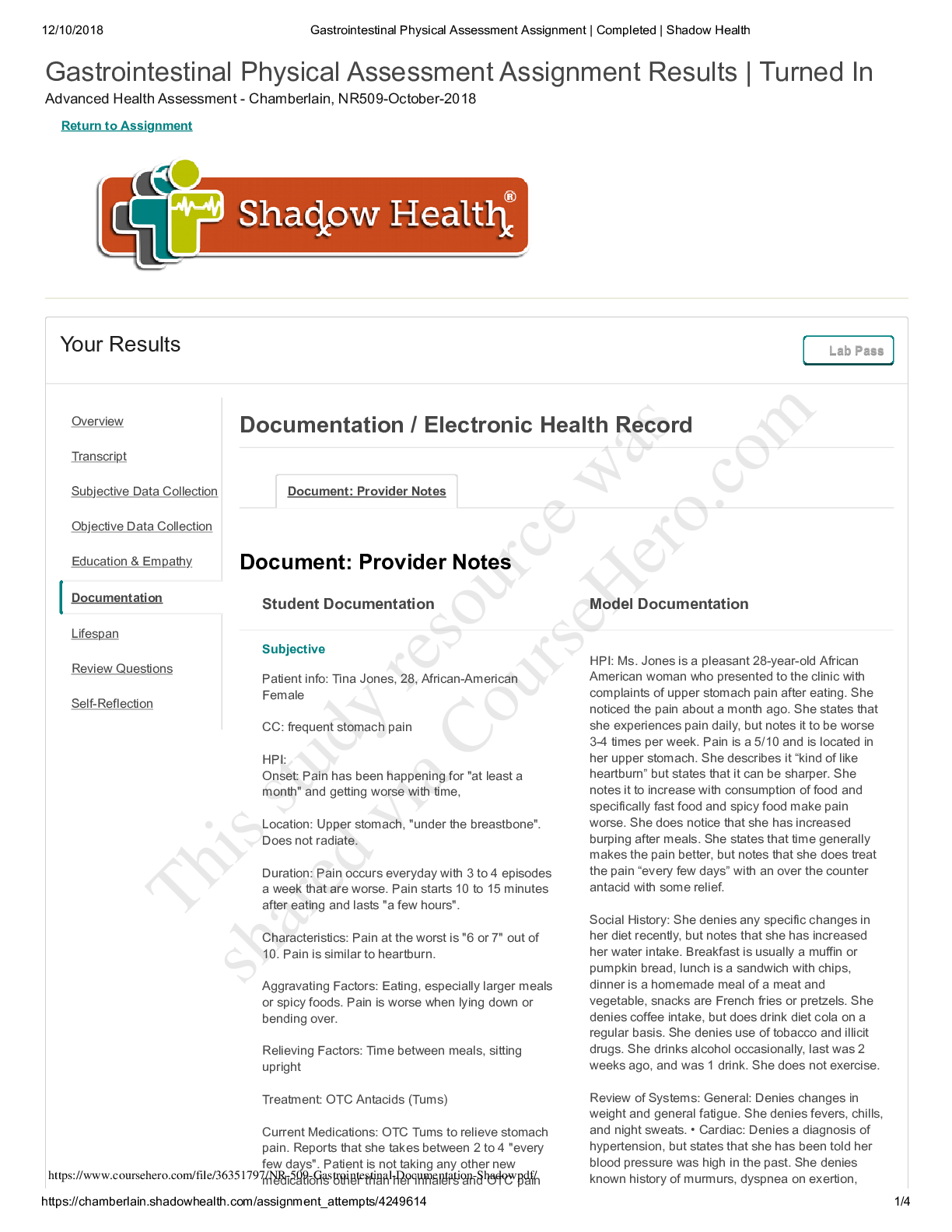*NURSING > STUDY GUIDE > Chamberlain College of Nursing - NR 507 Advanced Pathophysiology Week 3 Cardiovascular, Cellular, an (All)
Chamberlain College of Nursing - NR 507 Advanced Pathophysiology Week 3 Cardiovascular, Cellular, and Hematologic Disorders Discussion 2.
Document Content and Description Below
This week's graded topics relate to the following Course Outcomes (COs). 1 Analyze pathophysiologic mechanisms associated with selected disease states. (PO 1) 2 Differentiate the epidemiology, etio... logy, developmental considerations, pathogenesis, and clinical and laboratory manifestations of specific disease processes. (PO 1) 3 Examine the way in which homeostatic, adaptive, and compensatory physiological mechanisms can be supported and/or altered through specific therapeutic interventions. (PO 1, 7) 4 Distinguish risk factors associated with selected disease states. (PO 1) 5 Describe outcomes of disruptive or alterations in specific physiologic processes. (PO 1) 6 Distinguish risk factors associated with selected disease states. (PO 1) 7 Explore age-specific and developmental alterations in physiologic and disease states. (PO 1, 4) Discussion Discussion Part Two (graded) 0 Responses Lorna Durfee 5/16/2016 9:26:22 PM Discussion Part 2 Discussion Part Two (graded) Jesse is a 57-year-old male who presents with gradual onset of dyspnea on exertion and fatigue. He also complains of frequent dyspepsia with nausea and occasional epigastric pain. He states that at night he has trouble breathing especially while lying on his back. This is relieved by him sitting up. His vitals are 180/110, P = 88, T = 98.0 C, R = 20. Subjective: 57-year-old male who presents with gradual onset of dyspnea on exertion and fatigue. He also complains of frequent dyspepsia with nausea and occasional epigastric pain. The patient states that he has trouble breathing at night especially while lying on his back. This condition is relieved when he sits up. Objective: His vitals are 180/110, P = 88, T = 98.0 C, R = 20. Write a differential in this case and explain how each item in your differential fits and how it might not fit. Doctor Brown and Class: This patient, according to Gould and Dyer (2011) is exhibiting signs of paroxysmal nocturnal dyspnea and the presence of acute pulmonary edema. When sleeping, the patient has increased blood volume in the lungs leading to fluid in the alveoli. The fluid will interfere with diffusion of oxygen and therefore lung expansion (Gould & Dyer, 2011, p. 300). This condition leads to pulmonary edema and can be caused by left-sided heart failure. 0 0 DIFFERENTIAL: CONGESTIVE HEART FAILURE: Gould and Dyer (2011) state that congestive heart failure (CHF) occurs when the heart can no longer pump the necessary blood to meet all the demands of the body metabolically. Congestive heart failure can happen as a result of infarction or valve defect. It can arise from increased demands placed on the heart, such as hypertension or disease of the lung. One side of the heart fails first then the other. Infarction of the left ventricle or hypertension affects the left ventricle first. Pulmonary valve stenosis can affect the right ventricle. It is important to decipher which side it is. It is leftsided or right-sided CHF (Gould & Dyer, 2011, p. 297). There is a reduced flow of blood into the systemic circulation, and then the kidneys. These conditions lead to the secretion of increased renin and aldosterone. The result is vasoconstriction and an increased afterload and increased blood volume or preload which adds more work for the heart (Gould & Dyer, 2011, p. 298). The sympathetic nervous system then increases heart rate and peripheral resistance. There is a decrease in the efficiency of the heart. The heart change dilates, and the cardiac muscle then hypertrophies. The wall of the heart ventricle becomes thick. This condition leads to increased demand for blood supply to the myometrium. The myocardial cells die and are replaced with fibrous tissue (Gould & Dyer, 2011, p. 299). This item may fit: Dyspnea on exertion - Wahls (2012) relates that chemoreceptors in the brain and vascular system, as well as mechanoreceptors in the chest wall as well as the diaphragm and vagal receptors, regulate breathing. The cortical and cerebral pathways allow appraisal of the status of the lungs. When a patient has dyspnea it can be respiratory, neurogenic or cardiac in origin (Wahls, 2012, p. 173). Shortness of breath can be related to myocardial ischemia and congestive failure as well as COPD, lung disease and pneumonia and disorders that are psychogenic. He states that cardiac and pulmonary etiology dominates in most of the cases (Wahls, 2012, p.173). The description of the exacerbation of heart failure is a sensation of shortness of breath on exertion (Wahls, 2012, p. 174). This item may not fit: Because the patient could have another condition that may be causing the dyspnea on both exertion and at night. Schwartzstein (2015) confirms that dyspnea is acute when it develops over hours to days and chronic if more than four to eight weeks. The cause of dyspnea could be a new problem or a worsening underlying disease (e.g., asthma, COPD, or heart failure) (Schwartzstein, 2016). This may fit: Fatigue – The American Heart Association (2015) relates tiredness and fatigue are part of the signs and symptoms of heart failure. The heart cannot pump enough blood to meet the demands of the body. The body then sends the blood from less vital organs, the muscles in the limbs, and sends it to the heart and brain. The result is fatigue (The American Heart Association, 2015). This item may not fit: Because fatigue can happen for various reasons. Further evaluation is warranted. This item may fit: Dyspepsia and epigastric pain – This condition could be caused by angina. The National Heart, Lung, and Blood Institute (2011) remind us that symptoms of pressure, burning and tightness in the chest are signs of angina. It starts behind the breastbone. Also, there can be a pain in the arms, neck, jaw, throat or back. Sometimes it is hard to describe where the pain is coming from (The National Heart, Lung and Blood Institute, 2011). Angina is related to Coronary Heart Disease. Patients that I have cared for sometimes have had excess fluid in the body, and it can cause congestion, and this can be from congestive heart failure. This item may not fit: We do not know what other medical issues are present. There needs to be an evaluation of this patient with testing and further physical examination. This may fit: Nocturnal Dyspnea - When sleeping the patient has increased blood volume in the lungs, and this leads to fluid in the alveoli, and that will interfere with diffusion of oxygen and therefore lung expansion (Gould & Dyer, 2011, p. 300). This condition could lead to nocturnal dyspnea and could be a sign that the heart is not functioning properly. This item may not fit: However, there could be another problem such as COPD or pulmonary function issues. Testing is needed. This may fit: Blood Pressure: 180/110 - The systolic and diastolic pressures are both elevated. With left-sided heart failure, the heart moves oxygen-rich blood from the left to the left atrium and then to the left ventricle. With left-sided heart failure, there can be an inability of the left ventricle to contract normally. It cannot push enough of the blood into circulation. The left ventricle loses its ability to relax because the muscle is stiff. The heart cannot fill with blood properly with resting in between beats (The American Heart Association, 2015). This item may not fit: The high blood pressure can be from hypertension and needs to be ruled out. We need to identify what type of hypertension exists. What tests would you order? What immediate treatment would you consider giving this patient and what treatment when he went home? Assume your first differential is definitive. Tests to order and Treatment: Colucci (2015) states that heart failure is complex syndrome clinically. It can result in any disorder that impairs the heart and ventricle to fill with or eject blood. There are specific symptoms: such as dyspnea and fatigue, and signs relating to fluid retention. The ways to assess cardiac function is numerous. There needs to be a careful history and physical (Colucci, 2016). Arnold (2013) informs us that heart failure is a syndrome of ventricular dysfunction. With left ventricular failure, there is shortness of breath and fatigue. With right failure, it causes peripheral and abdominal fluid accumulation. The ventricles are involved either together or separately. The basis of the initial diagnosis is on clinical findings. The support of this diagnosis can be by chest x-ray, echocardiography and obtaining levels of plasma natriuretic peptides. He suggests as a treatment to start with patient education, diuretic medication, ACE inhibitors, angiotensin II receptor blockers, beta-blockers, and other medications. Also the use of digitalis and pacemakers and to definitively find the underlying disorder (Arnold, 2013). Now, he comes back to your clinic 3 months later and both his ankles are slightly swollen. What possible explanations are there for this observation? If this patient has congestive heart failure, swelling in both ankles is another sign. This condition means that the patient is retaining fluid. Sterns (2016) relates that edema in the ankles is called peripheral edema. He could now have pulmonary edema and worsening heart failure. He needs an evaluation for chronic venous disease, deep vein thrombosis, heart failure and a review of his medications (Sterns, 2016). [Show More]
Last updated: 2 years ago
Preview 1 out of 23 pages

Buy this document to get the full access instantly
Instant Download Access after purchase
Buy NowInstant download
We Accept:

Reviews( 0 )
$14.50
Can't find what you want? Try our AI powered Search
Document information
Connected school, study & course
About the document
Uploaded On
Oct 20, 2020
Number of pages
23
Written in
Additional information
This document has been written for:
Uploaded
Oct 20, 2020
Downloads
0
Views
80











